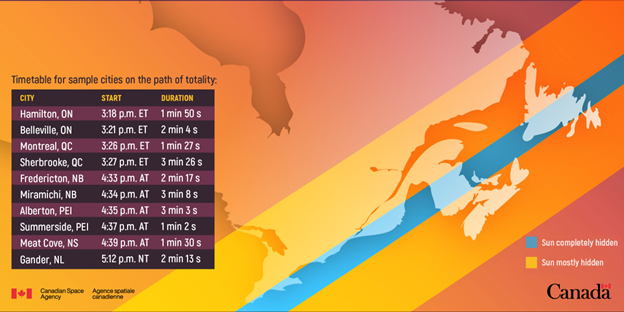By Kim Morris, Borealis Blog editor
On April 8, a total eclipse of the sun will occur over North America. According to Space.com, “a total solar eclipse happens when the moon appears the same size in the sky as the sun, or slightly larger, so fully covers the disk of the sun, giving observers a view of the sun’s outer atmosphere, the corona.”
In Canada, the path of totality—where the moon passes between the Earth and the Sun and completely obscures the star—occurs over Ontario, Quebec, New Brunswick, Nova Scotia, Prince Edward Island and Newfoundland.

On April 8, 2024, there will be a total eclipse of the sun. It will be seen at sites across North America (weather permitting). Map: Canadian Space Agency.
If you live in these areas, you can use an interactive path map to find out when the eclipse starts, how much of the sun’s disc will be obscured, and how long the event will last.
Remember to use appropriate eye protection when directly looking at the sun under any circumstances.
This is your last opportunity to see a total solar eclipse in Canada for a while. The next one to traverse Canada isn’t until August 23, 2044.
So, find out when and where you can view this extraordinary event, grab your eye protection, and hope for clear skies.
To learn more about solar eclipses, read the Science Borealis post The path of totality by Kira Hoffman which describes the last North American total solar eclipse (August 21, 2017).
Feature image: a sequence of images taken of the total solar eclipse event over Madras, Oregon on August 21, 2017. Image: NASA/Aubrey Gemignani.




